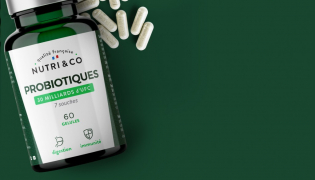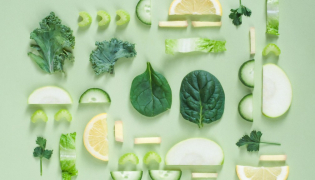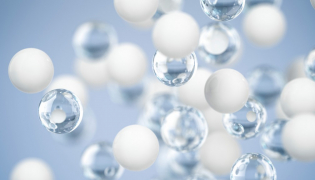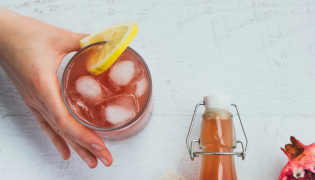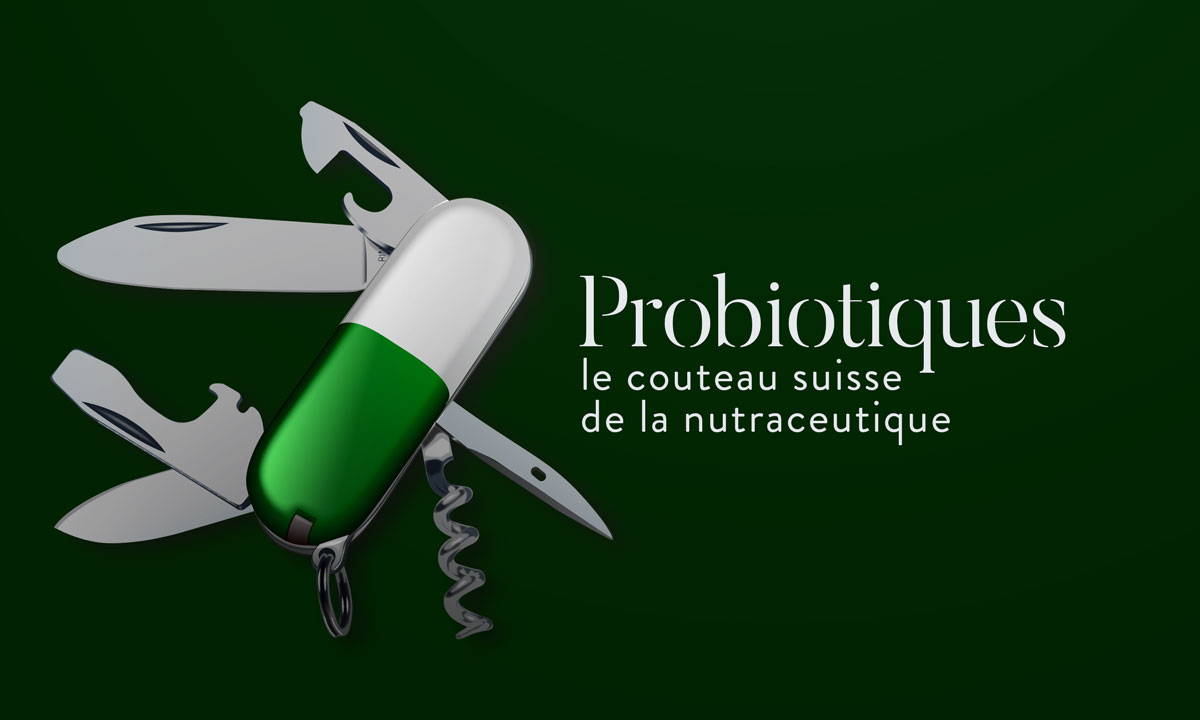
CE QU'IL FAUT RETENIR :
- "Probiotics" is the hottest word in the nutraceutical world
- Probiotics are mainly talked about for their benefits on digestion
- Among other applications, the action on the immune system is one of the most recognized and documented
- It remains a challenge: to know what you are buying from an abundant and above all very market-oriented offer...
"Probiotics with board, steam, sauce. Probiotic soup, probiotic stew, probiotic cocktail, probiotic salad, probiotic hamburger..." If Robert Zemeckis had to make Forrest Gump today, chances are Forrest Gump's best friend, Bubba, wouldn't be a shrimp fisherman. First of all, since Deepwater Horizon has been there, there is nothing very alive in the Gulf of Mexico anymore. Secondly, in 2019, the ingredient that we are putting into every sauce is no longer Bubba shrimp, but probiotics.
A quick look at Google or a visit to a pharmacy is enough to realize the phenomenon. And market figures confirm that probiotics are among the most sought-after, sought-after and growing ingredients today (IQVIA, 2019).
What are probiotics ?
By the way, do we need to remind you of this?What are probiotics? These "good" bacteria that populate our digestive system and that help us to digest have become so well known that everyone now knows them. The technical vocabulary has even become mainstream ("What strains are you taking now?") Let's remember that when we talk about strains or probiotics, we are mainly talking about families of bacteria, (prokaryotic cell, no nucleus), but that yeasts (eukaryotic cell, with a nucleus) also have a role to play in the digestive system. Some yeast strains have an international reputation, such as the famous Saccharomyces boulardii, which is extremely well documented and has an implacable efficacy (1). And what about bacteria then, such as Bifidobacterium and other lactobacilli popularized on TV with "it feels better inside and you can see it outside". There is still a more mysterious question: where do these little creatures come from that we like to eat? Well as usual, no mystery at Nutri&Co, we reveal everything.

Where did that come from ?
First of all, when we talk about "strain", we are talking about a specific bacterium among a species of similar bacteria, with a very specific DNA sequence or genome (2). The majority of strains on the market are of human origin, which means that they are naturally present in the human intestines. We give you the technical details of their samples. Some animal strains or strains extracted from the ground (yuck) have been studied for use as probiotics, but remain rarer. And fortunately so, because their safety is not always proven (3).
Once the strains are isolated, they are fermented. That must have been a word you heard quite frequently. This step simply consists in reproducing the bacteria: we put a very small amount in a solution, we put them well, around 30°C according to the strains, and we feed them with sugar (roughly speaking). And they reproduce quietly. At the end of the process, the medium is removed and the bacteria are much more numerous than at the beginning (4). So you can see in passing why talking about "BIO" probiotics can't make sense. Unless the original strain comes from an ORGANIC human intestine ?
But it is still not finished, once the strains are concentrated in a mother solution, they are dried on a powder, called support (often maltodextrin or starch) and cold stored. This is the white probiotic powder you see in your capsules or sachets. This mix is freeze-dried (dried therefore) and puts the strains in "dormant" and sheltered mode. It is kept in a cool place and especially away from any source of humidity. Because it is what probiotics fear: water. In the presence of water, animals wake up and cannot survive outside their natural environment (your intestines) and without food (sugars). This is the challenge for the manufacturer who fills the capsules: how to carry out these steps without degrading too many bacteria? And this sensitivity to water requires us to be very careful (4) :
- Find a producer capable of filling the capsules under good conditions and away from humidity
- Do not mix probiotics with other ingredients in the same capsule, EXCEPT if stability is demonstrated (ask for studies)
- Gastro-resistant capsules that protect the strains until they reach your intestines
- Apply high doses to ensure that with the inevitable losses, enough bacteria arrive alive and operational in your intestines
- Adapted packaging that protects the product throughout its life (on your breakfast table, in the cupboard, etc.)
Once you have selected the strains and the bottle caper who will put them in capsules (and believe us, we have turned the market around, they are not out on the streets), you can make a quality probiotic.

What's the point ?
To accompany the commercial momentum around probiotics, science is making great strides. Indeed, if the primary role of probiotics is to restore the intestinal flora to improve transit, researchers quickly made the link with the immune system (5, 6, 7). And the products on the market reflect the predominance of these two indications: nearly 75% of probiotics sold in France concern the digestive system. The immune system is in second place, with about 15% of sales. Behind, we see the appearance of probiotics for everything: women's health, sports, children, cosmetics, sleep, dirty character...
Because of marketing, probiotics can also be found in all kinds of sauces: microencapsulated, deactivated, spores, etc.
The stated aim is to protect these living organisms from damage during transport, production and consumption. Don't worry, Curiosity will soon bring us back bacteria found on the planet Mars that are even resistant to radiation (8)! Let's be serious: we know today that there is no need for all these devices, nor to choose extreme strains to send good bacteria where you need them. It is just a matter of knowing what you are doing: the right strains, with the right doses, even for very complex applications such as vaginal flora (9).
Probio cure in September : a good idea ?
Let us put aside the very specific applications precisely, and let us focus today on the immune system. Indeed, it is autumn, the season of dead leaves and especially small colds and other gastros. And since 70% to 80% of the immune system is located in the intestine, it seems a good idea to protect yourself by adding probiotics (10, 11).
But how do probiotics help the immune system? Data have been accumulating since the 1990s, and revolve around 3 main axes (12, 13, 14) :
- Reduction of inflammation,
- Occupation of adhesion sites targeted by bad bacteria: basically, the intestine is populated with good bacteria, leaving no more room for the bad ones that are evacuated,
- Stimulation (AND regulation) of the immune system,
- All this in addition to digestive comfort...
And the data do not stop at clinical or mechanistic studies. In addition to the fairly solid specific data on certain strains, particularly for the regulation of the immune response, and therefore the severity of symptoms (15,16), a new, more global study has shown the effects of probiotic consumption on the health costs associated with winter infections. Fewer sick people, and more moderate symptoms for the less fortunate, would reduce drug consultations and purchases (17). What more could you ask for? So we can say it without blinking: yes, probiotics can be an effective tool to prevent small colds and can even reduce the effects of germs that fall through the cracks. The question is which probiotics are the most effective.
So how to choose your probiotic ?
- Remember that this is not just a PDU question (article link) Verify that the formula is complete, that it is built with a solid rational, ideally with documented strains. Taking several strains increases the chances of success.
- Check that the formula is stable. The simpler it is, the safer it is. Avoid overly extensive mixtures with probiotics, plants, minerals etc. unless stability is demonstrated, which is rarely the case.
- Avoid promises that are too "too much". No, today's probiotic mixes will not make you lose weight, nor will they reduce your stress or enhance your skin. Some very specific strains come on the market with more or less solid data on these applications, let's give researchers some time to better understand them.
- Don't be distracted by the devices: microencapsulated or not, it is the quality of the mix and the scientific documentation of the strains that will make the difference.
- Also turn to natural sources of probiotics: yogurt, olives, pickles, kimchi for warriors.
One important detail remains to be noted: accompany your cure with quality dietary fiber, called "prebiotic fibers", to maximize its effect and especially to put your own intestinal flora in order of battle. But that's another story that amply deserves its own articles. Stay tuned...
1. Czeucka et al., Review article: yeast as probiotics -- Saccharomyces boulardii, Alimentary Pharmacology and Therapeutics, 15;26(6), 2007, 767-778
2. Si la classification et la nomenclature des micro-organisme vous intéresse : https://www.universalis.fr/encyclopedie/bacteries/11-classification-des-bacteries/
3. Sornplang et al., Probiotic isolates from unconventionnal sources: a review, Journal of Animal Science and Technology, 58(26), 2016
4. Fenster et al., The production and Delivery of Probiotics: A review of a practical approach, Microorganisms, 7(83), 2019, 1-17
5. R. Fuller AFRC, Probiotics in man and animals, Journal of applied bacteriology, 66, 1989, 365-378
6. Turchet et al., Effect of fermented milk containing the probiotic Lactobacillus casei DN-114001 on winter infections in free-living elderly subjects: a randomised, controlled pilot study, The Journal Of Nutrition and Healthy Aging, 7(2), 2003, 75-77 7
7. M.E Sanders et al., Probiotics and prebiotics in intestinal health and disease: from biology to the clinic, Nature Reviews, 16(10à, 2019, 605-616
8. Musilova et al., Isolation of Radiation-Resistant Bacteria from Mars analog Antarctic dry valleys by preselection, and the correlation between radiation and desiccation resistance, Astrobiology, 15(12), 2015, 1076-1090
9. Vásquez et al., Oral administration of Lactobacillus and Bifidobacterium strains of intestinal and vaginal origin to healthy human females: Re-isolation from faeces and vagina, Microbial Ecology in Health And Disease, 17, 2005, 15-20
10. Platt et al., Immunity in the Gut, British Society for Immunology. Lien: https://www.immunology.org/public-information/bitesized-immunology/%C3%B3rganos-y-tejidos/immunity-in-the-gut
11. Celiberto et al., Inflammatory bowel disease and immunonutrition: novel therapeutic approaches through modulation of diet and the gut microbiome, Immunology, 155(1), 2018, 36-52
12. Isolauri et al., Probiotics: effects on immunity, The American Journal of Clinical Nutrition, 73(2), 2001, 444-450
13. Hemarajata et al., Effects of probiotics on gut microbiota: mechanisms of intestinal immunomodulation and neuromodulation, Therapeutic Advances in Gastroenterology, 6(1), 2013, 39-51
14. Galdeano et al., Beneficial effects of Probiotic Consumption on the Immune System, Anals of Nutrition & Metabolism, 74(2), 2019, 115-124
15. Busch et al., Randomized, Double Blind and Placebo Controlled Study Using a Combination of Two Probiotic Lactobacilli to Alleviate Symptoms and Frequency of Common Cold, Food and Nutrition Sciences, 4, 2013, 13-20
16. Berggren et al., Randomised, double-blind and placebo-controlled study using new probiotic lactobacilli for strengthening the body immune defence against viral infections. European Journal of Nutrition, 50(3), 2011, 203-210
17. Lenoir-Wijnkoop et al., Probiotics Reduce Health Care Cost and Societal Impact of Flu-Like Respiratory Tract Infections in the USA: An Economic Modeling Study, Frontiers in Pharmacology, 10, 2019, 1-9




